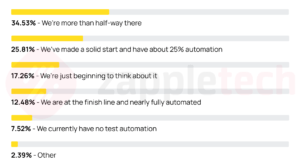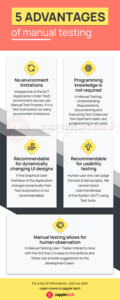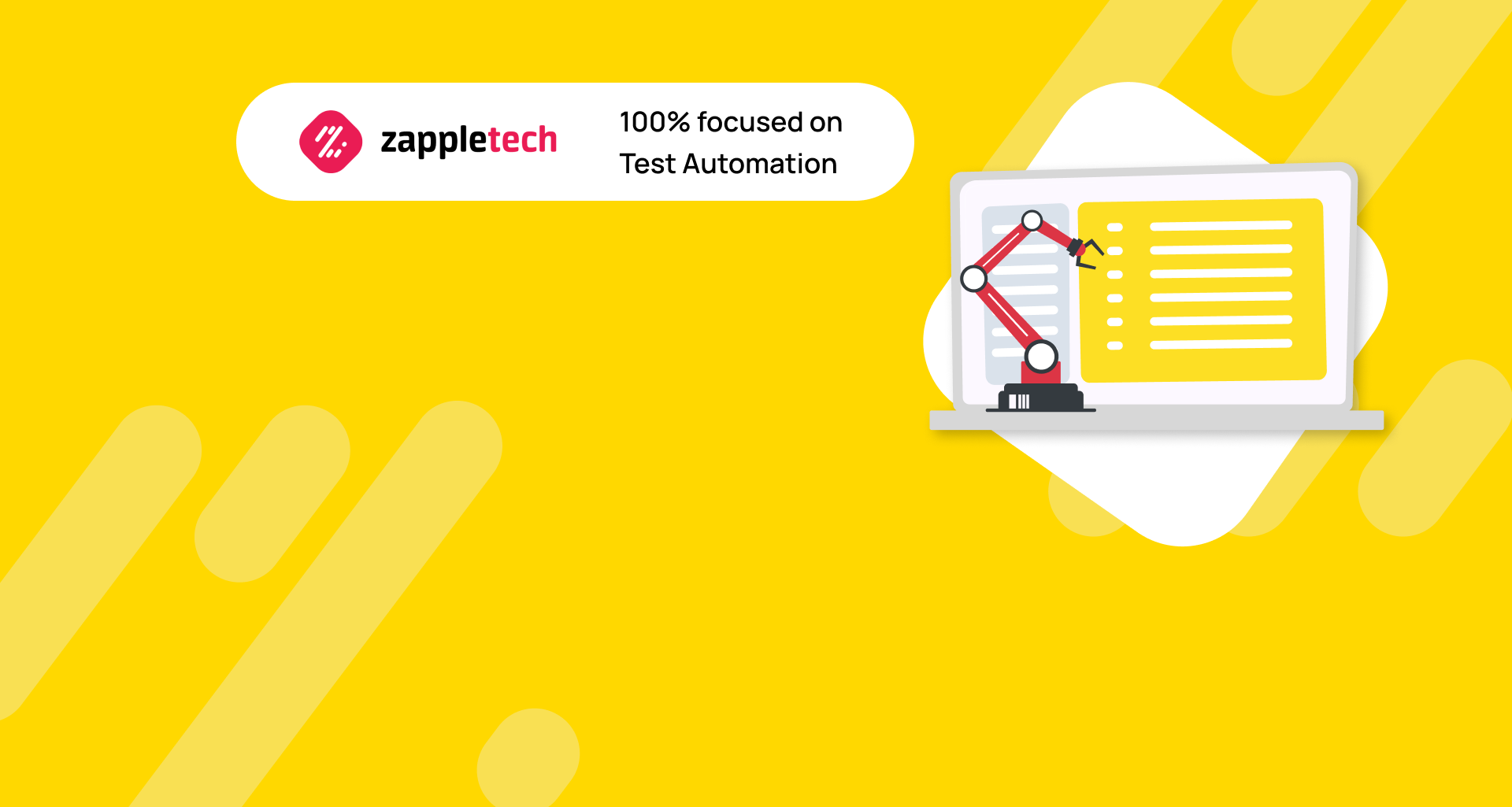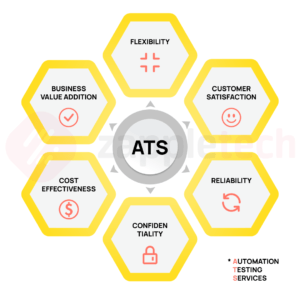Table of Contents
Benefits of automation testing: introduction
Modern software is a complex system uniting plenty of components. They must work smoothly and perform the functionality written in the specification. The software development process is complex as well since it combines numerous technologies, departments, and professionals. The benefits of automation testing include ensuring these components work correctly and efficiently.
Software testing is one of the key stages in the software development lifecycle. It is used at all stages of the development process and helps to spot if there are any errors and inefficiencies in the software performance. Its final goal is to verify if the software works right and is built according to the customer requirements.
Testing is a big area, uniting a wide amount of techniques and tools. There are two main types: automated testing and manual testing. In this article, we will analyze both of them and tell you about the differences and benefits of automation testing over manual testing.
Automated vs manual testing comparison
In manual testing, the QA engineer describes several scenarios and manually executes particular inputs and actions to test the response of software.
Test automation engineers write the scripts and use the tools to prepare the test cases. After the launch, the automation tests execute the steps that automatically verify the scenario. Though the testing process is automated, it still requires manual work to create the testing scripts and configure the tools.
Both these testing types have advantages and disadvantages. For the best working efficiency, it is better to know, which cases suit better to manual and automated testing.
Automated testing versus manual testing has long been a debate in software development circles, each approach bringing its own set of benefits and advantages to the table. While manual testing relies on human intervention to execute test cases and validate software functionalities, automation testing leverages tools and scripts to perform these tasks programmatically.
One of the primary benefits of automation testing is its efficiency in repetitive tasks. Automated scripts can execute test cases much faster and more reliably than human testers, which significantly speeds up the testing process. This efficiency leads to quicker turnaround times for testing cycles, allowing development teams to release software updates more frequently and with higher confidence in quality.
Moreover, automation testing excels in scenarios where tests need to be repeated across different environments or configurations. Once automated, these tests can be run consistently without variations in execution, ensuring thorough validation across platforms and reducing the chances of human error.
Regarding scalability, automation testing offers distinct advantages over its manual counterpart. As software projects grow in complexity and scope, maintaining test coverage becomes increasingly challenging. Automation allows for the creation of comprehensive test suites that can be easily expanded and modified as the application evolves. This scalability ensures that new features and changes can be thoroughly tested without requiring a proportional increase in testing resources.
Another key advantage of automation testing over manual testing is its ability to increase test coverage and accuracy. Automated scripts can execute many test cases in parallel, covering different aspects of the software simultaneously. This comprehensive approach helps identify bugs and issues early in the development cycle, reducing the overall cost and effort required for bug fixes later on.
Despite these advantages, manual testing remains crucial in certain contexts, particularly for exploratory testing and scenarios that require human judgment or subjective evaluation. Human testers can uncover usability issues, edge cases, and unexpected behaviors that automated scripts might overlook. Therefore, a balanced approach often combines both automated and manual testing techniques to leverage their respective strengths effectively.
Benefits of automation testing
Every software product is tested before seeing the world. QA engineers are trying to spot the bugs before the release, but some of them escape and reappear. Test automation is one of the best way to increase the efficiency and test coverage of your software.
Firstly, automation testing enhances efficiency by executing test cases swiftly and consistently. Unlike manual testing, which relies on human execution and interpretation, automated scripts can run repetitive tests across various scenarios without fatigue or variation. This speed accelerates the testing process, enabling faster feedback on software quality and quicker deployment of updates.
Secondly, the advantages of automation testing over manual testing include its ability to increase test coverage comprehensively. Automated tests can validate a wide range of functionalities and edge cases, ensuring thorough testing of the software under different conditions. This broad coverage minimizes the risk of undiscovered bugs and enhances overall software reliability.
Another significant benefit is scalability. As software projects grow in complexity and size, maintaining adequate test coverage becomes increasingly challenging. Automation testing addresses this by allowing testers to create extensive test suites that can be executed repeatedly across multiple environments. This scalability ensures that as the application evolves, testing efforts can keep pace without a proportional increase in resources.
The advantages of automation testing over manual testing — higher speed, saving costs, a higher percentage of spotted errors. However, it is not yet commonly adopted. 34.53% of surveyed QA engineers said that their companies have automated more than 50% of testing processes, and only 12.48% are at the finish line. 17.26% of companies are just starting automation and 7.52% have no automation at all.

Let’s speak about the benefits of automation testing in more detail.
 Time-saving
Time-saving
Instead of manually checking each screen, the tester writes a script that performs the testing operations automatically- Higher test coverage
Automated testing increases the number of possible testing operations and the depth of checking - Reusability of the test suite
The QA automation engineer writes one script and reuses it in the further development cycles at no additional cost. - Cost-effectiveness
Automation testing requires more initial investments, but it is cost-effecting at a long distance - Faster time-to-market
Automation testing helps to spend less time at testing operations and reduces the entire development cycle - Eliminating human mistakes
Automated testing eliminates the human factor and gives nearly 100% of accuracy - More test cases are available
Automation testing can execute scenarios that are impossible for the manual one - Automated control at all stages
The testing scripts can be launched automatically and provide immediate feedback at any code change - Improving team spirit
Automation testing helps to eliminate repetitive tasks and leave the challenging ones that will increase the motivation of testers
Time-saving
With manual testing, the human goes to each application screen, tries different input combinations, compares the output to the expected one, and records the observation. So, manual tests consist of similar actions that must be repeated upon each change of the code, testing the app behavior in different environments and configurations.
With automated testing, the human uses the software or writes the script that performs the above-mentioned operations automatically.
As the result, manual testers spend time on each operation, while automated tests require human work only for writing the scripts or operating the testing software. All the repetitive operations are automated and will take only several minutes instead of several hours of manual work.
Higher test coverage
The manual tester can run a limited number of tests in a time unit. The scope of possible manual tests is limited as well. With automation testing, it is possible to write new tests, covering more complex use cases and add them to the test suite
Using automated testing, you can increase the number and depth of the test scope. The testing scripts can see the content of the application, the data and the internal functions and determine the product behavior. The number of test scenarios that can be executed by automation testing is almost unlimited. This provides the level of test coverage that is impossible to achieve with manual testing.
Reusability of test suite
The test cases are repeated during the different development cycles — each time after the code is modified, in different environments and hardware configurations. It’s costly and time-consuming to run over the tests manually.
With automated tests, the engineer writes the script one time and reuses it during the entire development cycle at no additional cost. Sometimes, it is even possible to reuse the test suit even in a different project.
Cost-effectiveness
Although setting up the automation testing might be expensive at the initial stage of the project, it is more cost-effective in a long run.
A manual tester can run the tests only during the 8-hour working day, but the QA automation engineer will spend 8 hours creating a script, and it will run the testing during the remaining 16 hours for no additional costs. The authors of a white paper calculated that introducing automation testing reduces the cost of each test hour from $78 to $17.54.
The later the bug is found, the more expensive it is to fix it. Since automated testing increases test coverage, there is a higher opportunity to find a defect at an earlier stage, and this is a direct financial saving for the company.
Faster time to market
As was already mentioned, it is necessary to run the tests after each change of the source code. The automated tests can be run all day long and process more cases in a time unit. Due to this, the software development cycle reduces, and it is possible to quickly make changes in the software. As a result, switching to automation testing reduces the product time to market.
Eliminating human mistakes
With monotonous manual testing, there is a bigger possibility of making a human mistake, especially in complex scenarios.
On the contrary, automated testing gives nearly 100% of accuracy and log each executed action. Besides, it not only shows the fact of a mistake, but also gives an opportunity to see the contents of the application, the data in the table, and other internal files. This helps not only spot the mistakes but also to determine, what exactly has gone wrong.
More test cases are available
An automated test provides such features that are impossible to execute with a manual. For example, the QA automation engineer can create a script simulating thousands of users interacting with the application. It will help to check, how the app works under the high load, and it’s impossible to perform manually.
Automation testing accelerates testing cycles, improves coverage, and enhances reliability. Use it for efficiency in repetitive tasks and scalability, but integrate with manual testing for comprehensive quality assurance.Sergey AlmyashevCOO, ZappleTech Inc.
Automated control at all stages
The automated tests can help the developers to spot minor issues quickly before sending the app to the QA department. The testing script can run automatically once the code is changed and provide immediate feedback in case of failure. The developers can fix the issue instantly, and the QA engineers will do deeper testing.
Improving team spirit
Automating routine and repetitive tasks with the help of software will allow your team to work on more challenging tasks. The developers and QA engineers will improve their skill, confidence, motivation and this will have a positive impact on the entire teamwork.
When is it better to use manual testing?
Manual tests are executed directly in the application, simulating the actions of end-users. Despite the growing trend on test automation, manual testing is still important in software development. Now we will speak about the advantages of manual testing over automation.

- Short-term projects
Manual testing doesn’t require initial investments and is more cost-effective in short-term projects with a limited budget - UI\UX testing
A script cannot substitute human thought and run UI\UX testing that is based on the perception of the end-user - Un-automatable scenarios
Some testing cases are impossible to automate, and manual testing is still used for them - Limited time for testing
If the project has limited time or budget for testing, manual exploratory and ad hoc testing are used
Short-term projects
Short-term projects often present unique challenges in software development, requiring rapid delivery without compromising quality. In such contexts, automation testing offers distinct advantages that can significantly streamline the testing process and enhance overall project efficiency.
One of the primary benefits of automation testing in short-term projects is its ability to expedite test execution. Automated scripts can run tests much faster than manual testing, allowing teams to validate functionality quickly and continuously throughout the project lifecycle. This accelerated testing cycle enables rapid feedback on code changes, facilitating faster iterations and quicker resolution of issues.
Moreover, automation testing enhances test coverage comprehensively, even within the constraints of a short timeline. Automated scripts can be designed to execute a wide range of test cases across different scenarios and environments, ensuring thorough validation of critical functionalities. This broad coverage reduces the risk of undetected bugs and increases confidence in the software’s stability and reliability within tight deadlines.
UI/UX testing
UI/UX testing, focusing on the user interface and user experience aspects of software applications, is crucial for ensuring that products are intuitive, visually appealing, and functionally robust. While automation testing offers numerous advantages, particularly in efficiency and scalability, UI/UX testing presents unique challenges that often require a blend of automated and manual approaches.
Automated testing is highly effective in validating functional aspects of the user interface. It can systematically verify UI elements, such as buttons, forms, navigation flows, and interactive features, across different browsers and devices. This ensures consistency in functionality and helps identify bugs related to user interaction quickly and reliably.
Another advantage of automation testing in UI/UX testing is its ability to perform regression testing efficiently. Automated scripts can be set up to run repetitive tests on UI components after each code change, ensuring that new updates do not introduce unintended issues or regressions in user experience. This continuous validation helps maintain the integrity of the UI throughout the development lifecycle.
Un-automatable scenarios
In the realm of software testing, while automation testing brings numerous advantages, there are certain scenarios that remain challenging or even impossible to automate effectively. These “un-automatable” scenarios highlight the limitations of automation testing despite its many benefits over manual testing.
One significant category of un-automatable scenarios involves user experience and usability testing. Evaluating how users interact with an application, including subjective assessments of aesthetics, intuitiveness, and overall user satisfaction, often requires human judgment and interpretation. While automated tests can verify functionality and behavior, they cannot fully replicate the nuanced feedback that human testers provide regarding user interface design and usability.
Similarly, exploratory testing poses challenges for automation. This type of testing relies on testers’ creativity, intuition, and ability to uncover unexpected behaviors or edge cases within the software. Exploratory testing is iterative and adaptive, making it difficult to script predefined test cases that can adequately simulate the spontaneous and unstructured nature of human exploration.
Exploratory testing
This type of testing supposes instant discovery of the project and its functionality. Exploratory testing isn’t logged in a test plan and supposes creating the test cases in mind and their instant execution and modification. Its goal is a deep study of product functionality and quick spotting of bugs. The results of exploratory testing can serve as a basis for further scenarios.
The efficiency of the exploratory testing directly depends on the tester’s creativity and product knowledge. They will help them to identify the bug aggregate and predict possible risks.
Ad hoc testing
This is fully improvisational testing that doesn’t have any documentation and test plan. It can be confused with exploratory testing, but the latter is a more structured one. During exploratory testing, the QA engineer has a plan in mind, the goal, and the system of the testing process.
Ad hoc testing is run when there is no time for successive testing. It will make sense only if the tester has general information about the product and understands its structure.
Benefits of automation testing: conclusion
Having read the article, you are now aware of the benefits of automated testing over manual testing and of the use cases for both of these types. Although automated testing is the growing trend and the future of software development, manual one is still in use and there are still cases when it is the best choice.
In conclusion, the benefits of automation testing underscore its pivotal role in modern software development practices. The efficiency, scalability, and reliability offered by automation testing significantly elevate the quality assurance process compared to manual testing alone.
Automation testing excels in executing test cases swiftly and consistently across various environments and configurations. This capability not only accelerates the testing cycle but also enhances the thoroughness of test coverage, identifying defects early in the development lifecycle. By automating repetitive tasks, teams can allocate human resources more strategically, focusing on exploratory testing and critical thinking aspects that require human intervention.
Moreover, the advantages of automation testing over manual testing extend to its ability to integrate seamlessly with continuous integration and continuous delivery (CI/CD) pipelines. Automated tests facilitate frequent deployments by providing rapid feedback on code changes, thereby supporting agile development methodologies and speeding up time-to-market.
Furthermore, automation testing improves the accuracy and reliability of test results by reducing the potential for human error in test execution and interpretation. This precision contributes to higher software quality, reducing overall costs associated with bug fixes and maintenance over the long term.
Automation testing speeds up testing, catches bugs early, and scales with your project. It’s great for repetitive tasks but remember to balance it with manual testing for thorough quality checks.Mykhailo PoliarushCEO, ZappleTech Inc.
While automation testing offers these compelling benefits, it is essential to recognize that manual testing remains indispensable for exploratory testing, usability assessments, and scenarios requiring human judgment. A balanced approach that combines both automation and manual testing leverages their respective strengths to achieve comprehensive software quality assurance.
In essence, the adoption of automation testing represents a strategic investment in enhancing productivity, ensuring software reliability, and meeting customer expectations consistently. By harnessing the advantages of automation testing, development teams can navigate the complexities of modern software development more effectively, delivering robust applications that align with business objectives and user needs.
If you have a project idea for implementation, contact our specialists to book a free consultation. We will explore the possible variants and offer you the best conditions.


 Time-saving
Time-saving



